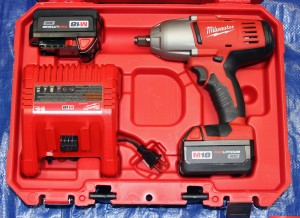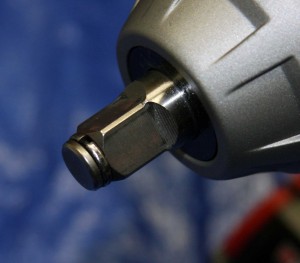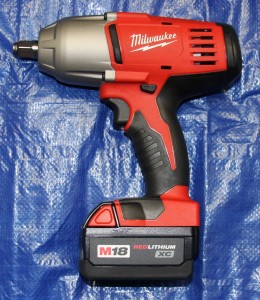Milwaukee Impact Wrench
Like lots of folks, I drive to the track in the car I drive on the track. I do have a separate set of track wheels & tires that take various/separate routes to the track. Part of my late Sunday afternoon ritual is to swap my track wheels for my street wheels as soon and as quickly as possible – so I am not the last dude watching the sunset while still at the track. You know the routine: set the brake, throw wheel chocks down, break the torque on each wheel bolt on the opposite side of the car from the chocks, jack up the that side of the car, remove bolts and track wheel, replace with street wheel, tighten the bolts, move to the other wheel on that side and repeat, lower the car, swap sides, and repeat. Torque each bolt. Put all the gear in the car, and the track wheels in their mode of transport. Ugh. It makes me tired just to write it, and it’s much worse after a long, hard, track day. Enter the Milwaukee impact wrench! The Milwaukee 2663-22 18-Volt M18 1/2-Inch High Torque Impact Wrench with Friction Ring is an awesome piece of gear. After a quite a bit of research, this Milwaukee impact wrench is the one I chose, and I am 100% convinced a made the best choice for me.
Here briefly were my ‘must haves’:
- Less than $500 (plenty of options much less than this, and I do have a budget.)
- 1/2-inch drive
- Battery powered (no guaranteed access to air at the track, plus my garage compressor is not big or powerful enough for an air impact wrench.)
- At least 250 FT-LB of torque (I read you need a wrench with a max torque at least twice what you think your working torque needs to be. My wheel bolts require 96 FT-LBs, so I chose 250 FT-LB as a minimum to give some extra margin. Plus, I occasionally have shops put my wheels on, and you never know when someone’s ‘calibrated’ trigger finger goes awry.)
- Batteries & charger included (I don’t have other heavy duty batteries lying about.)
- Good, quality brand with a decent guarantee
Nice to haves:
- Kit that includes a case of some sort case
- Relatively compact (I know this is a tradeoff – generally, but not always, the more compact you go, the lower the max torque.)
- Lithium ion battery (for size, weight, and durability.)
So what did I find; what led me to the Milwaukee impact wrench? I quickly narrowed my choices to a couple of Milwaukee models, a Bosch, a Sears/Craftsman, and a DeWalt. I have had good experience with Craftsman tools including my trusty torque wrench, and I have a DeWalt cordless drill that I love, so I was a bit biased in those directions to start. However, I ruled out the Craftsman as it had a 200 FT-LB max. The DeWalt had 300 FT-LB, and it was less expensive than the Milwaukee, but it was larger and heavier. The Bosch was just a little bigger, and it was rated at 500 FT-LB, but it was also ~25% more expensive than the Milwaukee. Another consideration was the fact that the Milwaukee impact wrench was pretty much universally praised on the web by people who depended upon it professionally. The Milwaukee met all of my ‘must haves’ as well as all of my ‘nice to haves’. It also carries a 5 year warranty on both the tool itself and the batteries. Nice. I think I could have been happy with the DeWalt or the Bosch, but the Milwaukee impact wrench seemed like the best choice for me. Now the question was which Milwaukee impact wrench. Milwaukee makes two nearly identical models, the 2662-22 with a
pin detent anvil, and the 2663-22 with a friction ring anvil. More research. I read some reviews where people had difficulty in quickly switching sockets with the pin detent – a no-no for my track use. I was buying this impact wrench to primarily save time and make my whole routine simpler and easier. So my choice was the Milwaukee 2663-22. Well, how did I do? In short, spot on. The batteries charge quickly and last a long time. The impact wrench feels good in my hands, and it’s easy to use. The first couple of times I put a socket on the anvil I struggled a bit – you essentially have to compress a little ring that’s slightly larger than the anvil. I don’t know if there was a bit of a break in period or I just got more proficient at swapping sockets, but it’s a breeze now. The 450 FT-LB of torque quickly breaks free the lug bolts that have been torqued to 96 FT-LB. Two other pieces of kit that I bought are a good, deep, thin-walled 19mm impact socket
and a 90 FT-LB torque stick. The torque stick prevents over-torquing the lug bolts, and after a couple of uses, I have gotten pretty good at getting close to the 96 FT-LB. My pass with a torque wrench after using the impact wrench with the torque stick shows that I am routinely getting within a quarter turn of the lug bolts to 96 FT-LB. I give a hearty recommendation for the Milwaukee 2663-22 18-Volt 1/2-inch high torque impact wrench kit
So far, I am 100% satisfied, and I got mine at Amazon: Milwaukee 2663-22 18-Volt M18 1/2-Inch High Torque Impact Wrench with Friction Ring
I also recommend a good impact socket (or set). You must use IMPACT sockets with this tool. I’m also very happy with the torque stick. I got both the torque stick and impact sock at Torque Stick. I’ll post an update after I’ve lived with this tool a little longer, and I’ll be happy to answer any comments or questions. Update 090512: After living with my Milwaukee impact wrench for a couple of months now, I have only good things to report. The battery life is excellent, and the friction ring has gotten easier to use – as I suspected, there was a bit of a break in period.




